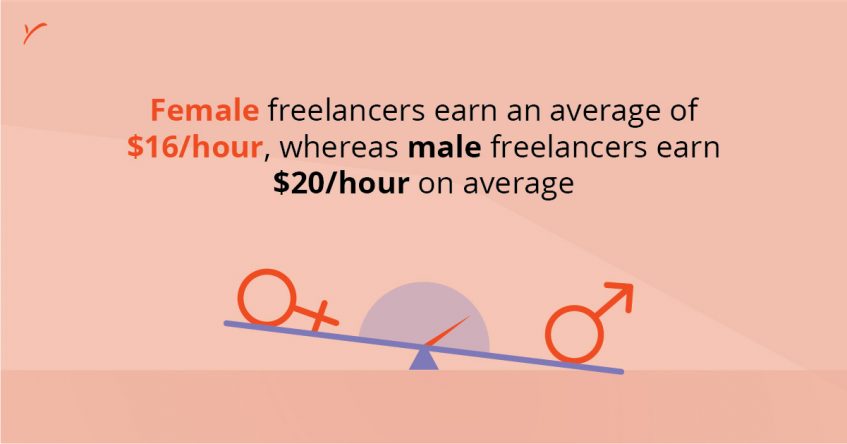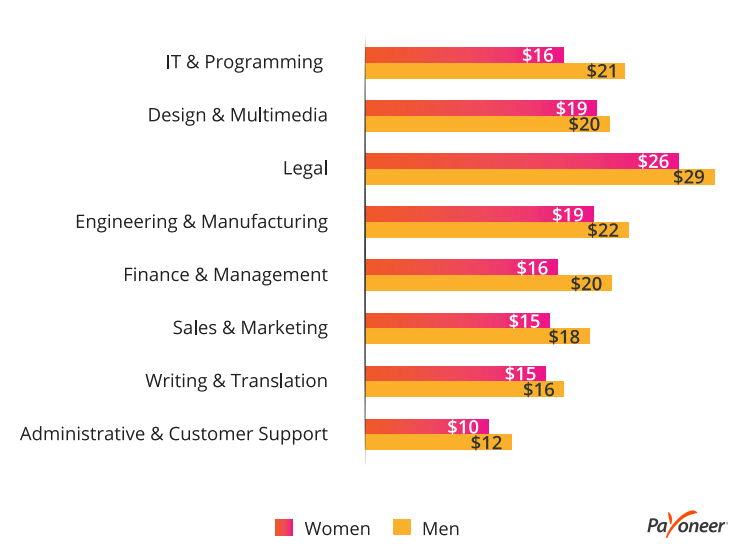
Women in Freelancing: There’s Progress, but Plenty More to Do
As a freelancer, it’s important for you to know the value of your services, as well as what other freelancers in the same field charge. In the corporate world, you hear a lot about the pay gap between men and women, but we rarely hear about it as it relates to freelancing.
The fact is: globally, women don’t earn as much as men do as freelancers. On average, women earn about 54% of what men earn for similar work around the world.
The Pink Collar Phenomenon
The really interesting thing about this disparity in freelance pay is that the majority of freelancers are female (though many are what’s called “gig workers,” and may not freelance full time.).
Especially in certain industries like writing, you’ll find more women freelancing, where, sadly, women seem to have the best success payment-wise writing about “pink” topics like health and relationships rather than harder stuff. It’s harder for them to get hired writing about topics like business or technology, and even more challenging to be paid for the work comparable to what men are paid.
Even in the freelancing industries they dominate, women still aren’t being paid what they’re worth. Women writers in Canada earn just 55% of what men writers do.


Reasons for the gap
We can all admit that the difference in freelance pay among the genders is unfair, but in order to change it, we need to first acknowledge the causes of the issue.
One of the causes of the discrepancy stem in a behavioral issue: a difference in confidence between sexes. It’s not sexist to say that many women are hesitant to ask for more money for a project, fearing rejection or missing out on the project altogether, where a man will fearlessly lay down what he wants to be paid. If he’s rejected, he negotiates.
Age and education also factor into the equation, naturally, though women with comparable degrees to men still earn less 10 years after graduating.
Add to this the fact that a business can hire a freelancer from anywhere in the world (with freelancers in certain countries charging far less than those in the US). A female freelancer must compete with not just men in her country but also those all over the globe.
Where the gap is most noticeable
While the gap in pay for freelancers seems fairly consistent across all industries, it’s most noticeable in IT and programming. There, women earn 75% of men’s hourly rate. On the other end, there’s only a small gap in pay for freelancers in design and multimedia, where women earn 95% of what men do.


Where women beat out men
The good news is: there are locations and industries where women are dominating the freelancing field.
In the US, female freelancers earn more than men in Washington, DC, Minneapolis, Atlanta, New York, and Los Angeles.
Countries where women make the same as men include Venezuela, Romania, and Mexico. In Bolivia and Indonesia, female freelancers actually earn more than their male counterparts.
Hopeful for the future
While the pay gap is something we can’t ignore, we can have hope for the future of women in freelancing. After all, not being an employee has certain perks. We can pick and choose the projects we work on, and if a project doesn’t pay enough, we can either negotiate or decline it.
The obstacle to overcome is believing in our own potential as freelancers. We have it within our control to not take any projects that dip below a certain threshold. We don’t have to take low-paying work. And yet, if we keep accepting it out of a sense of desperation and fear that the next project won’t come, we will perpetuate this wage gap.
And it’s also worth noting that simply having the ability to take on freelance work empowers women in countries like the Philippines, where horrid commute times and extreme poverty often make it challenging to make ends meet through a traditional job. Regardless of how much these women make in comparison to men in their countries, they are able to support their families in a way they couldn’t have even 15 years ago, thanks to freelancing.
Women, if you’re ready to change this statistic, learn to ask for what you’re worth. When you’re building out a quote (which I’d suggest never doing on the fly but taking time to think on, then email it to a potential client), add 20% to the number you were thinking. Test it out. See who bites. Then realize that you’ve been charging way too little all this time, and adjust your prices across the board.
And if you’ve been charging a flat rate for a project and you always end up doing more work than that fee covers, start charging by the hour.
We can’t change the gap in freelance wages overnight, but if we’re mindful and confident in how we do business as freelancers, we can change the tide together. We’re in this together, ladies. Let’s change the conversation away from how little we make and get some equality happening in the world.
Learn more about your value as a freelancer. Download the Freelancer Income Report for free.




